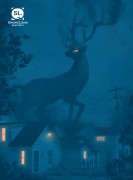The first question I always like to ask is if you could tell us a little about your process and craft for this story.
I think the most efficient thing to say here is that I knew I wanted to try to tell a story from the inside of a panic attack. I wanted to try to capture that sort of swirling, disassociative mess, when you’re sort of creating a tornado and trying to get out of it all at the same time.
I’m interested in the ways this story deals with various threats of violence: the deer and leopards, Fig’s unsettling presence, the rabbits to be hunted the next day. Can you tell us more about the process of layering these threats into the narrative?
Hmmm … OK. The honest answer? Here goes: I think there’s a very distinct feeling to living in the body of a prey animal, or perceiving yourself that way—and when you live like that, everything around you carries with it a certain threat of violence. (Sorry, that’s so dark! Dark question, dark answer, right?) Sometimes I watch people out in the world who just … live inside their bodies with no sense that they are prey, and it’s just so fascinating and enviable, isn’t it? I mean, to feel strong and capable of defending yourself at all times? It must be amazing! Then I see rabbits out munching away on some lawn and I think, how do you even manage? Why aren’t you trembling in the corner watching cartoons and eating comfort foods in your little hole all day long? I mean, at least I have a few—and Naadi has a few—places (and “places”) where we can retreat, lock the door, and tell ourselves we’re safe. Where can a rabbit go? They’re the ultimate in vulnerable.
Similarly, there seem to be various forms of isolation layered into the story. What was it like to work that in and balance it with the threats of violence?
I live in fear of these kinds of isolation—not at all the rural or being-alone kinds of isolation (both of which I love), but the isolation you feel when you’ve given up a layer of self-determination. Even something as simple as letting someone else drive you somewhere, or going somewhere you don’t really want to go, or being trapped under someone’s arm, or being mis-perceived a certain way and just letting that happen…they all take away one layer of being able to decide for yourself, don’t they?
But there are all of these normal little agreements we make where Yeah, OK, I’ll go along with this, and Yeah, OK, I’ll go along with that …. The steps are so little and one at a time and generally so not specifically disagreeable that it would be seen as strange to demur—but every once in a while, several layers down, we find ourselves in a situation we know we don’t really want to be in, but it’s sort of too late, right?
I think that “Cat Lady” story resonated with so many people because this sentiment maybe isn’t as unusual as we’d thought—and it obviously seems more than a little involved in #metoo, too. I guess this is the kind of isolation I was really trying to point to, as well as the isolation that comes from not really feeling like you can say anything unless—until—there’s some specific, clear, logical, and concrete complaint. Of course, by the time there is, the sequence of agreements you’ve made is generally so far gone that it’s hard to explain how you let yourself get there in the first place.
Your story incorporates the narrator’s memory of their Dadi and how and when memories resurface. What drew you to investigating this how/when for your character?
I’ve always just assumed that everyone has a very personal relationship with their own little brand of panic, and also has an evolving stable of little go-to, talk-me-down comforts they can turn to. I’m so incredibly curious about this—what a museum it would be!—but it somehow feels too personal to ask people, are there certain things they do, rituals they have, or even certain shows they watch when they’re sort of losing it?
I sort of tried this during a difficult period, after a significant loss. I asked my Facebook people if they had any very psyche-gentle television recommendations (a friend paraphrased this as “basically, the television version of Goodnight Moon”), and I was shocked by some of the recommendations people made. Who would enlist Call the Midwife as a soothing mechanism? But to each their own. Anyway, I suppose this whole line of thinking was probably swirling somewhere in the back of my mind, along with Dadi and Truman.
How do you view the relationship between the constraint of the story form (flash fiction) and the constraint in the story itself, such as the dark, the boyfriend’s arm, the cabin?
Fascinating question. I guess I hadn’t viewed that as a relationship! I’m in love with the constraint of the flash form. When I teach, I call it “fertile constraint,” and I’m such a huge believer in it. In terms of the constraint of the cabin, the arm, the dark … those are honestly my nightmare. Opposite of fertile constraint! Opposite of fertile constraint!
The thing I can’t shake about this story is that somewhere in that room, Naadi knows that Jeremy’s car keys have to be in the pocket of his jeans, and it would just be a matter of standing up, finding them, and driving away. Have we all been in situations where we play that little escape scenario on a loop, but don’t do it?



 The core workshop of SmokeLong Fitness is all in writing, so you can take part from anywhere at anytime. We are excited about creating a supportive, consistent and structured environment for flash writers to work on their craft in a community. We are thrilled and proud to say that our workshop participants have won, placed, or been listed in every major flash competition. Community works.
The core workshop of SmokeLong Fitness is all in writing, so you can take part from anywhere at anytime. We are excited about creating a supportive, consistent and structured environment for flash writers to work on their craft in a community. We are thrilled and proud to say that our workshop participants have won, placed, or been listed in every major flash competition. Community works.